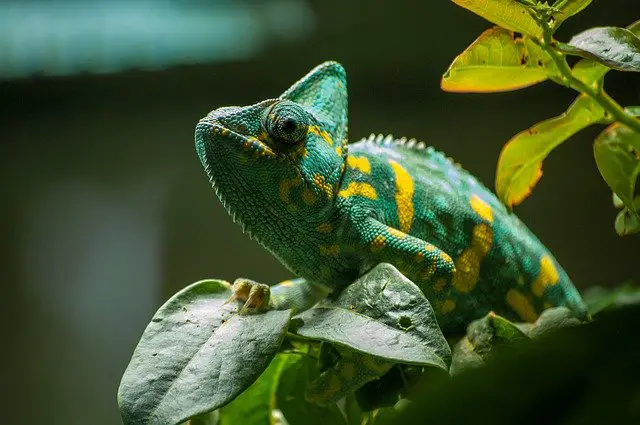This is a question that many people are asking as the weather gets warmer and temperatures continue to rise. Chameleons need warmth to living, but they can only tolerate so much heat. In this blog post, we will explore the ideal temperature range for chameleons and discuss what happens when they are exposed to excessive heat. We will also provide some tips on how to keep your chameleon safe during extreme weather conditions.
Temperature is an important factor when it comes to chameleon care. Chameleons thrive in temperatures that range from 70-85 degrees Fahrenheit, with a humidity level of around 80%. If the temperature exceeds 85 degrees or falls below 70 degrees, your chameleon may experience health problems. In extreme cases, excessive heat can even be fatal.
If you live in a hot climate or if the weather is unusually warm, it is important to take steps to keep your chameleon safe. You can do this by providing a shady spot for your chameleon to escape the sun and by using a fan to create airflow. Make sure that your chameleon’s water bowl is always full of freshwater, and check the temperature of the room where your chameleon lives regularly. If necessary, move your chameleon to a cooler location or provide additional ventilation for them by opening windows and doors.
What happens when a chameleon is exposed to high temperatures?
If a chameleon is exposed to high temperatures, it will enter a state of excessive heat and become lethargic. When this happens, the lizard’s metabolism slows down so that it can conserve its energy for thermoregulation. The lizard becomes inactive and may even lose consciousness if overheated long enough without proper care being given by an owner or breeder (which could result in death).
In addition to losing consciousness from lack of oxygen supply due to respiration rate slowing which results when hypoventilation occurs due to elevated body temperature – there are other health issues at risk too! For example, dehydration caused by insufficient water intake through drinking (because of thirst) or eating food that has been stored improperly resulting in bacterial growth (which leads to gastroenteritis).
Finally, hyperthermia (elevated body temperature) can lead to renal failure and death.
What you should do
So what can you do as an owner or breeder to help make sure your chameleon doesn’t get too hot? Make sure their enclosure is in a cool spot away from direct sunlight, have plenty of water available for them to drink, and mist the enclosure often with room-temperature water to keep the humidity levels up.
You should also check on them regularly throughout the day – especially if you see that they’ve stopped moving around or seem lethargic. If they’re exhibiting any of these signs it’s best to take them out of the heat source and give them some time to cool down
What happens if a Chameleon is exposed to low temperatures?
Chameleons are tropical creatures that can be found in Africa and Madagascar, mainly. They live in warm climates with temperatures ranging from 65 to 75 degrees Fahrenheit. If they are exposed to low temperatures for an extended period of time, it will lead to a condition called “chill” which is where the chameleon becomes sluggish or immobile due to being unable to regulate its body temperature properly.
As such, you should never keep your pet Chameleon in any environment without adequate heating elements for fear of chilling them out!
How hot is too hot?
Is there a safe range when keeping my chameleon as a pet? It all depends on what species they are! Some may need higher temperatures than others but generally speaking you should try not to exceed 85 degrees Fahrenheit (29 Celsius) with any type of lizard.
The heat that a chameleon feels is relative to its size, so if your pet reptile is small he/she may need more warmth than larger ones do because they will feel colder at lower temperatures than those who are bigger and heavier than them.
This means keeping an eye on what kind of enclosure or tank setup you have for your chameleon can make all the difference when it comes down to whether or not they’re getting enough airflow through their habitat so as long as there isn’t too much humidity in either one then everything should be fine! If this happens, however, we recommend using some additional heaters inside of the enclosure such as under-tank heating pads or ceramic heat lamps.
What is the minimum temperature for keeping a chameleon?
The minimum temperature to keep any type of lizard healthy and happy is 65 degrees Fahrenheit (18 Celsius). This means if you want to keep your pet reptile at home, they’ll need some sort of heating element in their habitat whether it’s an electric heater or even just putting them near a window where there are rays coming through during daytime hours when sunlight pours into the room!
Any lower than this range could cause issues with how well he/she can regulate body temperatures properly which may lead to illness because these creatures rely heavily on external sources for warmth- so make sure you keep that in mind when considering a pet Chameleon!
Conclusion
So, as you can see, the temperature range for keeping a chameleon is rather wide. What’s important to remember is that they come from tropical climates and prefer things on the warmer side- so don’t go too far below 65 degrees Fahrenheit (18 Celsius)! If you have any questions or concerns about your pet’s environment, always consult with a veterinarian who specializes in exotic animals to get their professional advice. Thanks for reading!




